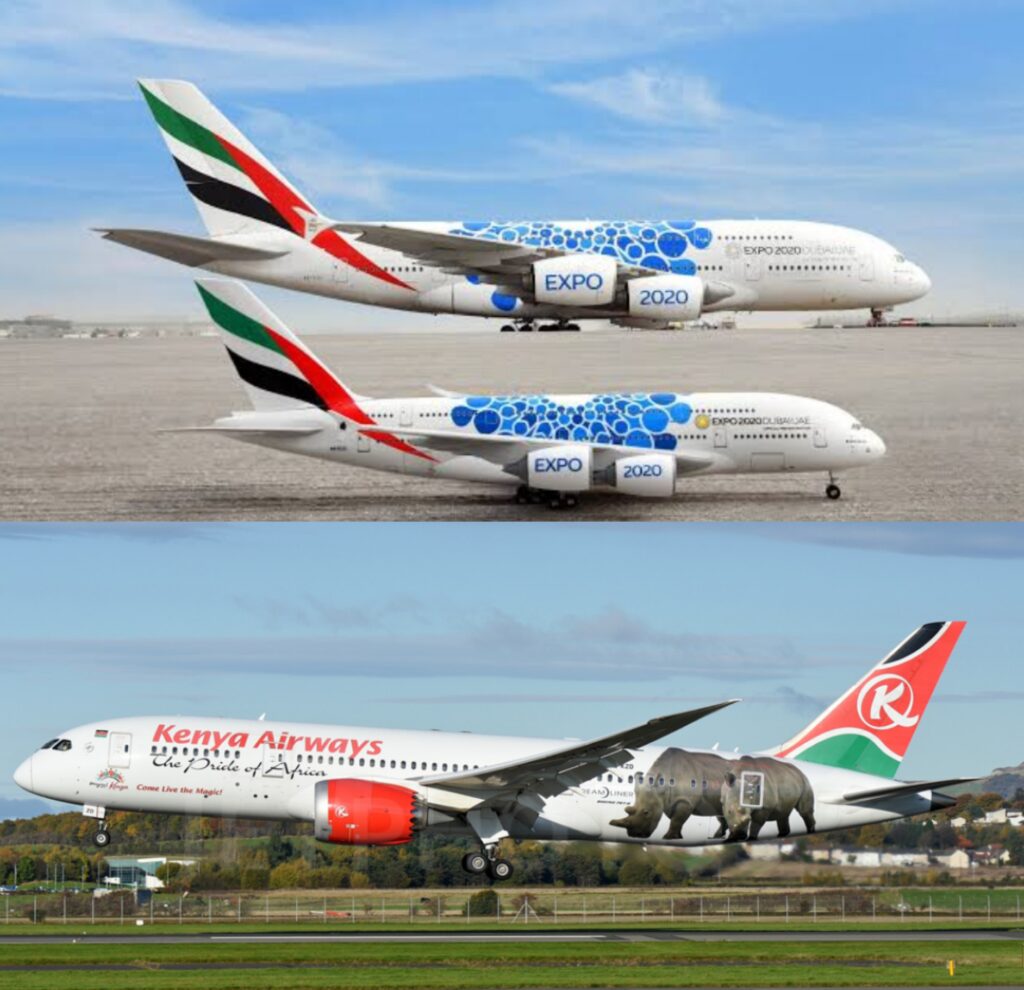Kenya Airways, the pride of Africa, has failed in promoting the pride of its mother nation, Kenya. There are many dimensions to this but I shall limit my thoughts to the not so familiar concept of aircraft liveries. To hit the ground running on this piece, let’s take a moment to understand what aircraft liveries mean and why they are gaining momentum in the aviation industry. The term livery signified a uniform style of clothing worn by servants who rendered their services to wealthy hogs and government bureaucrats. Initially, the aviation industry adopted liveries to create corporate identities and promote branding. The idea was similar to school uniforms which distinguishes school going children. After the second world war, aircraft liveries began to evolve and fresh, eye-catching and breathtaking designs were being imprinted on the fuselage. The pride of Africa was not left behind in this moment and in 2005, the airline redesigned its livery from the four stripes running all through the length of the body to what it is now.
Globalization has reengineered transport systems globally from facilitating the movement of people and cargo to being a source of product and service communication supporting the business community. This is clearly portrayed when you think about Kenya’s public transport system more so the matatu. Their colorful exterior designs that brighten the city center are often a decoy used to attract customers. Over time, some matatu saccos have decided to cash in on the opportunity and offer the business community a chance to advertise their value proposition through special liveries. As I mind my business in Nairobi Central Business District, I come across an unavoidable Swvl advertisement imprinted on a KBS bus and a few meters later a Telkom advertisement imprinted on a Citi Hoppa mini-bus.
Airlines globally have taken up the mantle to promote their home hubs. Middle Eastern carriers such as Emirates, Qatar and Etihad invest in special liveries in order to market special events or endowments that their countries possess. The United Arab Emirates hosted the Dubai 2020 expo, which attracted close to 10 million people from around the world. I personally came to know about the exhibition when a friend took a picture of an Emirates aircraft in Dubai that had been colorfully branded the Dubai 2020 Expo livery. The special branding of their fleet was significant, timely and profitable as the airline registered impressive passenger numbers during the event.
Late last year, Kenya Airways decided to slightly upgrade their liveries in a bid to support the struggling tourism sector that was greatly affected by the pandemic and this left me feeling insipid. Kenya is beautiful and I appreciate that tourism is a strong contributor in our economy but it is not the only contributor. I believe we can strategically position our country as a go to destination by exposing our hidden gems in sectors such as information technology, banking, finance and investment and agriculture. By imprinting wildlife images on aircraft, Kenya Airways is seeking to attract the leisure traveler who will spend a couple of nights in Masai Mara or Diani and fly back. However, they miss the opportunity to attract the business traveler who is constantly seeking opportunities and solutions and this has a longer and stronger impact to the economy than the leisure traveler.
Kenya Airways transports over 4 million passengers annually and this implies that air passengers all over the world come in contact with information printed on these ‘flying billboards’. As a business, Kenya Airways needs to align its strategy with the country’s overall economic ambitions. I believe the idea of having wildlife impressions on aircraft is short term, slightly backward and equivalent to Emirates marketing Dubai desert safaris as a major endowment at the expense of the Dubai 2020 Expo. The COVID-19 pandemic halted global mobility of people and this should have triggered conversations regarding investing and promoting sectors that can withstand unexpected occurrences. I prefer promoting initiatives such as the soon to be Nairobi International Financial Center hub which promises an enabling business environment for investors and which might create perpetual tourism for the country.
Lastly, I suppose the airline is missing out on generating additional income through its liveries. Offering the business community an opportunity to explore international visibility could potentially create a win-win outcome for the country and transacting parties. As I spread my opinion regarding this interesting phenomenon, my mind takes me back to H. Jackson Brown Jr. who said, “Nothing is more expensive than a missed opportunity”.
No related posts.



I just wish people in KQ can read this and use it in creating strategy
Very insightful 👌🏾👏🏽
I can’t tell you how much I love and enjoy reading your work. I’ve read it at least 100 times 😅😅. The wisdom, I stun. I conquer with Isaac, KQ should read this. It’s your move KQ. Come on.